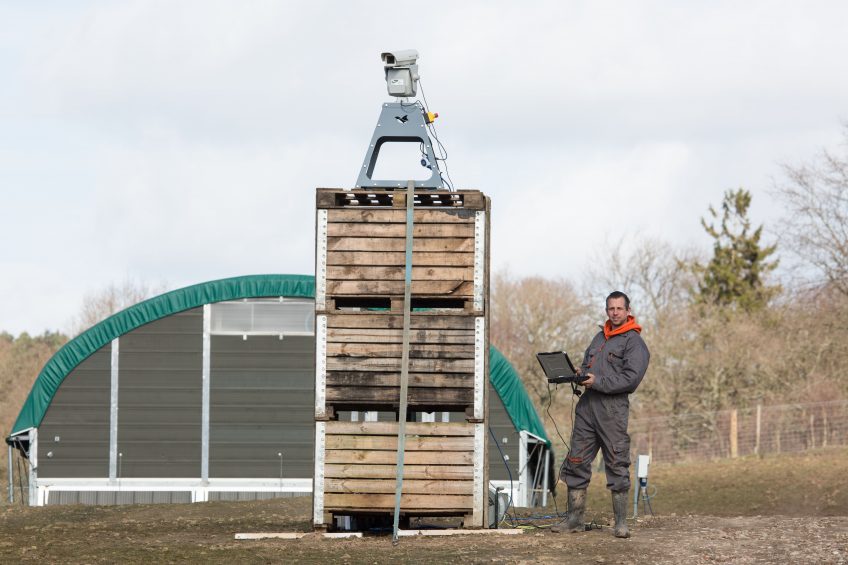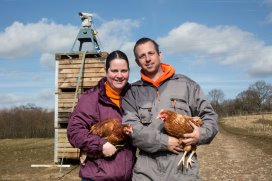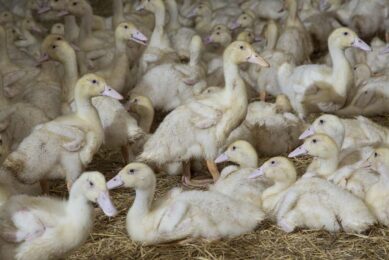Layers protected by lasers

Small scale, with an eye for tradition and with a holistic view on nature and farm life – surely this doesn’t make biodynamic agriculture as innovative as one might think. British-based layer farmer Hoeberichts will prove you wrong. He protects his free-range organic hens from avian influenza infection, coming from wild birds, by using laser technology.
Poultry farmers all around the world go to great lengths to protect their birds from avian influenza. In many countries there are mandatory or voluntary housing orders and in others biosecurity is enforced to the maximum. However, it is hard to protect poultry that range freely. Housing the birds for a prolonged time will cost the farmer free-range status of the eggs and thus lead to substantial value loss. If there is any chance to give the birds outdoor access again, that is embraced immediately, even when it is not entirely sure if the contaminated wild birds have migrated onwards yet. In Britain the government partly retracted the mandatory housing ban in some areas, but stated that poultry farmers should take all possible precautions to protect their flock. Usually outdoor access is limited by farmers and protected by installing netting, however Hoeberichts took it to a whole different level.

Biography
Name: Daniel and Karen Hoeberichts
Place: East Sussex, United Kingdom
Company: Orchards Egg farm of the Hoeberichts family is a biodynamic egg and fruit farm. On an orchard of 60 acres – apples, pears and a variety of soft fruits are produced and 4,500 layers produce high valued organic eggs.
The Star Trek approach to protecting hens!
At Hoeberichts Orchard Eggs in West Sussex, the small flock of 4,500 biodynamic organic hens roam freely around 60 acres of orchards. Now that the government lifted the housing orders, they have 24/7 access to the outdoors. Moveable houses within the grounds are accessible when they need it. From a standpoint of protection against avian influenza, the 60 acres outdoor area is a nightmare. The solution Daniël Hoeberichts and his wife Karen found could have come from a combination of Star Trek and Mad Max movies. In the middle of the orchard the couple built a makeshift tower of crates, with a fully automatic revolving laser ‘gun’ on top of it shooting out green beams of light. On the other side of the premises a somewhat more old school measure to scare wild birds is in place in the form of a propane gas canon. Mr Hoeberichts says: “The hens quickly adapted to the laser lights as well as the loud bangs from the propane canon. Hopefully the wild birds stay as afraid as they are now.”
Multiple measures in place
Orchard Eggs has taken advantage of the latest laser technology available from a Dutch company in order to scare off wild migratory birds and prevent them mixing with the farm’s chickens. As the British government recently extended the avian influenza (bird flu) prevention zone to April 2017, it also raised the biosecurity requirements poultry farmers must adhere to if they want to keep their birds outdoors. Karen and Daniel Hoeberichts, said once they heard of the new laser technology, steps were taken to set it up to complement the farm’s other biosecurity measures. According to the developers, the principle of repelling birds with a laser beam is inspired by nature. The birds think the approaching laser beam is a physical object, thus they go into survival mode and fly away.
The laser protects the hens without harming wild birds
Daniel Hoeberichts adds: “We want to do everything to keep them safe from infection. Once we heard about the Agrilaser Autonomic it seemed like an ideal solution to complement all of our other biosecurity measures.” The automated laser is an innovative method to repel unwanted birds without causing harm to the wild birds, the chickens and the surrounding environment. The system has been developed by the Dutch company, Bird Control Group, in co-operation with the Technical University of Delft in the Netherlands.
The laser is 90%-100% effective in dispersing wild birds
The laser is silent and shows effectiveness of 90% to 100% in bird dispersal at farms, which the company says makes it a viable alternative to the expensive method of installing nets all around the entire poultry farm. Because Hoeberichts sees the system as an experiment, he rented the system for € 600 a month. It would sell for € 8,000. Dan England, director of distributors PestFix (UK) states: “The outbreak of avian influenza here in the UK back in December 2016 has caused untold stress to the poultry and egg sector. The advent of new APHA (Animal & Plant Health Authority) protocol allows free-range birds outdoors, if they can be kept segregated from wild birds. With this rule, the laser technology for bird dispersal comes into its own. Because they are domesticated, the hens are unaffected by the laser.”
The UK set up the prevention zone from 6 December 2016, which meant that all poultry and captive bird keepers had to apply heightened biosecurity including keeping their birds indoors if possible, or otherwise separated from wild birds.
This was renewed on 4 January 2017 to last until 28 February 2017. This further zone will remain in force until at least the end of April 2017.

Still a significant risk
British Free Range Egg Producers Association (BFREPA) chief executive Robert Gooch says: “BFREPA members are proud to produce a product which so many consumers love and they very much want their hens to have access to the outside. However, there is still a significant risk that free-range flocks could catch avian influenza while migratory wild birds are in the country in significant numbers. It’s important that consumers understand that this is not a food safety scare. Eggs remain a fantastic source of nutrition and are safe to eat.”
From 1 March Defra have identified certain parts of England as higher risk, where poultry must remain housed (or the range completely netted), while outside of these areas free-range producers may be able to let their birds back out with enhanced biosecurity. It is up to individual producers, together with advice from their vets to assess the local area risks for their own flocks.
“Some producers will be able to let their birds out and some will decide, on the balance of local risk and to protect their birds’ health, to keep them indoors until the danger of infection has passed. Gooch adds: “Boxes of free-range eggs are being stickered to inform consumers that they may have been laid by hens which are temporarily housed to protect their welfare. We hope that this is a short-term measure and that it will soon be safe for all free-range producers to allow birds back outside. Producers are ensuring that housed birds are being well looked after and strict biosecurity protocols are followed at all times.”
Join 31,000+ subscribers
Subscribe to our newsletter to stay updated about all the need-to-know content in the poultry sector, three times a week. Beheer
Beheer








 WP Admin
WP Admin  Bewerk bericht
Bewerk bericht